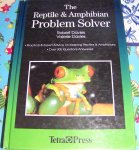The Reptile and Amphibian Problem Solver, by Robert Davies and Valerie Davies (Tetra Press, 1997. 208 pages).
A woman at work found this for me at a garage sale and picked it up thinking I might like it. So sometimes it pays never to shut up about your hobbies.
Here's the short version: the reptile section is useful. The salamander section is not.
The book is 140 pages to 60 pages of reptiles to amphibians, and of the 60 amphibian pages, only eight are salamanders. So I'll start with them.
The authors call the red Spotted newt (Notophthalmus viridescens) mostly aquatic. They mention the eft stage, but barely explain that this is a terrestrial phase, and then only to say it can be (artificially) bypassed by keeping the larvae aquatic. I don't think that's very nice. I didn't much care for the other species accounts either. Though I didn't see anything really harmful (other than the eft thing), I didn't find it all that helpful either; just a smattering of incomplete information. The talk about heating pads in the amphibian setup section also bothered me, what is it with these suggestions for heating your amphibians? And they don't talk about heating frogs vs. newts, either. My new pet peeve rears its ugly head.
I can't really comment on the frog section, my knowledge about frogs is less than minimal. All I can say is there was no Couch's Spadefoot in the book. However, I made a new friend, a little baby horned frog so keen on eating, that it's hanging from its keeper's finger. But don't fear, I'm not becoming a frogophile. I sometimes coo at babies, all the while relieved they're not mine.
Maybe you'll find sometihig you didn't know, maybe something will be helpful for you. It didn't do anything for me.
The salamander part is not very good, though the reptile section is much better. I learned a lot from the reptile section, and the book would have been better if they'd stuck to their strength.
Placed here and there within the introductory section are boxes on different subjects, for example, a comparison of various substrates; live vs. artificial plants; and the pros of captive bred vs. the cons of wild caught animals. There was an educational section on breeding, and I learned a lot of helpful info in the reptile section. It's like a different book.
Each chapter discusses its subject, and then ends with a Q&A section. The Q&A format is just another way of presenting information, but it makes it interesting, sort of like reading a Dear Abby column for herps. I offer here some of the questions:
How does starvation show in turtles?
Can paint be used in a vivarium?
Can a reptile be kept in a small cage and allowed out for exercise? (1)
Do all reptiles need ultraviolet light?
What is "gut loading"?
Can frozen foods be thawed in a microwave?(2)
Can I offer uneaten food to another animal?
Is it true reptile eggs should never be turned?
I didn't mention this Q&A stuff in the amphibian section because it wasn't worth mentioning then.
I liked the reptile section and found it useful and I recommend it if it comes your way. But if you get this book, rip out the newt section, cut out the pretty pictures and tape them to your fridge, put a piece of duct tape over the words "& Amphibian" on the cover (see second picture below), and just use the reptile section.
And remember, keep yapping to anyone who will listen about your hobby! Maybe you'll get free stuff!
-------------------------------------
(1) "This is not a good idea," they state, and then explain why.
(2) I'm not telling. Try it yourself. ..................Just kidding. Don't try it.
But if you want some microwave fun, put a marshmallow in for 15-30 seconds and watch it blow up to many times its normal size. Then when you take it out, it slowly shrinks again. You can blow it up again, and shrink it, several times, until it loses its will to live.
A woman at work found this for me at a garage sale and picked it up thinking I might like it. So sometimes it pays never to shut up about your hobbies.
Here's the short version: the reptile section is useful. The salamander section is not.
The book is 140 pages to 60 pages of reptiles to amphibians, and of the 60 amphibian pages, only eight are salamanders. So I'll start with them.
The authors call the red Spotted newt (Notophthalmus viridescens) mostly aquatic. They mention the eft stage, but barely explain that this is a terrestrial phase, and then only to say it can be (artificially) bypassed by keeping the larvae aquatic. I don't think that's very nice. I didn't much care for the other species accounts either. Though I didn't see anything really harmful (other than the eft thing), I didn't find it all that helpful either; just a smattering of incomplete information. The talk about heating pads in the amphibian setup section also bothered me, what is it with these suggestions for heating your amphibians? And they don't talk about heating frogs vs. newts, either. My new pet peeve rears its ugly head.
I can't really comment on the frog section, my knowledge about frogs is less than minimal. All I can say is there was no Couch's Spadefoot in the book. However, I made a new friend, a little baby horned frog so keen on eating, that it's hanging from its keeper's finger. But don't fear, I'm not becoming a frogophile. I sometimes coo at babies, all the while relieved they're not mine.
Maybe you'll find sometihig you didn't know, maybe something will be helpful for you. It didn't do anything for me.
The salamander part is not very good, though the reptile section is much better. I learned a lot from the reptile section, and the book would have been better if they'd stuck to their strength.
Placed here and there within the introductory section are boxes on different subjects, for example, a comparison of various substrates; live vs. artificial plants; and the pros of captive bred vs. the cons of wild caught animals. There was an educational section on breeding, and I learned a lot of helpful info in the reptile section. It's like a different book.
Each chapter discusses its subject, and then ends with a Q&A section. The Q&A format is just another way of presenting information, but it makes it interesting, sort of like reading a Dear Abby column for herps. I offer here some of the questions:
How does starvation show in turtles?
Can paint be used in a vivarium?
Can a reptile be kept in a small cage and allowed out for exercise? (1)
Do all reptiles need ultraviolet light?
What is "gut loading"?
Can frozen foods be thawed in a microwave?(2)
Can I offer uneaten food to another animal?
Is it true reptile eggs should never be turned?
I didn't mention this Q&A stuff in the amphibian section because it wasn't worth mentioning then.
I liked the reptile section and found it useful and I recommend it if it comes your way. But if you get this book, rip out the newt section, cut out the pretty pictures and tape them to your fridge, put a piece of duct tape over the words "& Amphibian" on the cover (see second picture below), and just use the reptile section.
And remember, keep yapping to anyone who will listen about your hobby! Maybe you'll get free stuff!
-------------------------------------
(1) "This is not a good idea," they state, and then explain why.
(2) I'm not telling. Try it yourself. ..................Just kidding. Don't try it.
But if you want some microwave fun, put a marshmallow in for 15-30 seconds and watch it blow up to many times its normal size. Then when you take it out, it slowly shrinks again. You can blow it up again, and shrink it, several times, until it loses its will to live.


